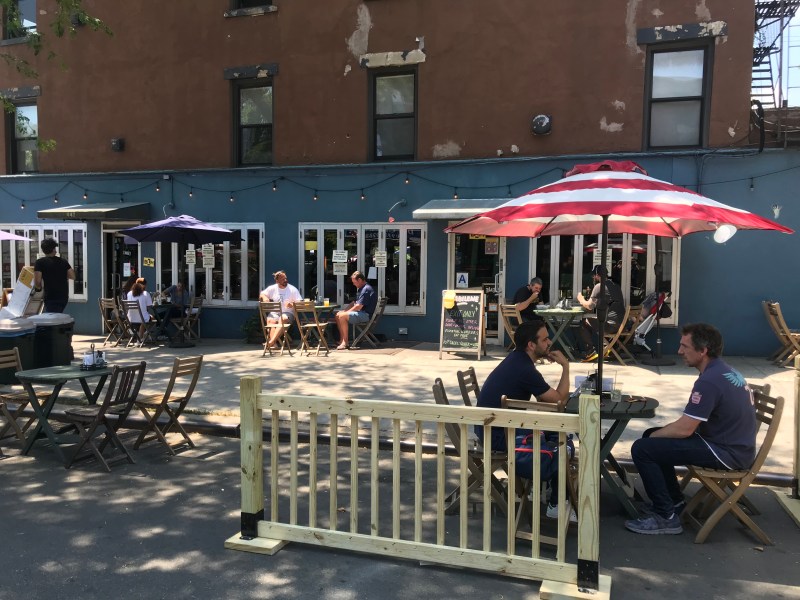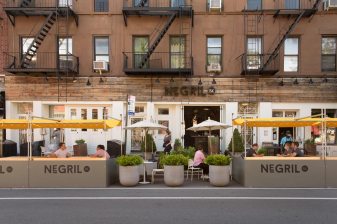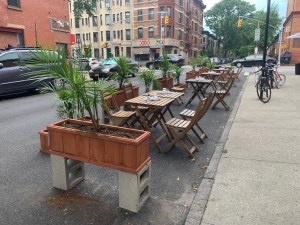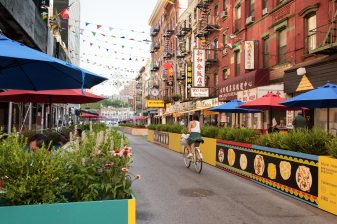Improv at the Curbside: Outdoor Dining Program Kicks Off With Varied Security Barriers
Umbrellas, construction barriers, picket fencing — you name it, restaurant owners will try it in their bid to keep cars away from diners. Car-parkers beware!

The city’s outdoor dining program — which allows restaurants to turn parking spots in front of their storefronts into socially-distanced seating areas, as well as put tables on sidewalks — is testing the ingenuity of restaurant owners, who yesterday could be seen using a variety of barriers as they tried to keep diners safe in the brand-new arrangements.
Left to their own devices (the city did not offer much in the way of guidance) owners placed planters, umbrellas, stationary ropes, picket fencing and even construction barriers next to their curbs in order to demarcate their new territory in the roadway and ward off automobiles — a strategy necessitated by Mayor de Blasio’s refusal to close any restaurant-heavy streets to car traffic, as other cities have done to support their restaurant industries during the COVID-19 pandemic. According to early talking points about the plan, the city said it would “identify new open streets on commercial strips with large number of restaurants and bars,” but so far it has not proposed any. Of course, restaurants can create seating areas directly in front of their establishments on any of the existing open streets, which now number about 40 miles.
The so-called al fresco dining initiative was the signal program of the second phase of the city’s re-opening yesterday, but improvisation was its watchword in more ways than one: Restaurant owners also were using homemade signs to alert car-parkers that the eateries were claiming the curbside space.
“We are actually in the process today of emailing all the restaurants who applied for curb space a sort of somewhat official sign, which says ‘don’t park here, open dining,’” DOT commissioner Polly Trottenberg said on Monday during the mayor’s morning briefing, acknowledging that motorists could hurt the program. “Between SBS and DOT’s borough commissioner offices, we’re going to be on the ground today helping to resolve those conflicts wherever we can. But it’s probably going to take a little time to sort itself out. So, a little patience as we turn those parking spaces into restaurant space.”
George Constantinou, who owns a trio of restaurants on 5th Avenue in Park Slope, told Streetsblog that he was excited to use the parking spots in front of Bogota Latin Bistro and Miti Miti for street seating, even if he initially worried about the safety of putting seats in the street. Constantinou also said that he was able to get to his restaurants at 8 a.m. on Monday and claim the space he’d been given before the parking rush started.
“Ultimately safety from cars and coronavirus is at the top of our list,” said Constantinou. “At first it seemed kind of tricky, like ‘Wait we’re putting tables in the street, is that safe?’ But there have been parklets put up throughout the city over the years and that’s the model I think they’re going after.”

At Abilene, a Court Street eatery just southeast of Constantinou’s small empire, the restaurant’s owners also had some trepidation around street seating and car traffic.
“We were a little freaked out, and we wanted to keep people as safe as we could,” said co-owner Leah Allen. “And we’re going to figure out how to make it even more obvious. We want to keep it safe from drivers, it’s a relatively busy street.”
“That’s one reason we have the umbrellas,” added co-owner Michael O’Neill. “The shade is nice, but you can also see them clearly when you’re coming down the street.”
In other parts of the city, the barriers on the sidewalk seemed to a little but more of an improv act than the planters and drilled down wooden barriers in Park Slope and Cobble Hill, but diners still appeared to flock to the new eating option.

I’m not a fan of Brazen Fox but they designed their outdoor seating very nicely pic.twitter.com/3zAjluL2e9
— Yosef Kessler (@yosefontwo) June 23, 2020

Berry Street in Williamsburg seems to be doing berry good when comes to restaurants taking advantage of #OpenStreetsNYC @HenryRinehart @StreetsblogNYC @ReynosoBrooklyn @AndrewRigie pic.twitter.com/uFIoX6wixY
— Streetfilms (Now 1,100 films strong!) (@Streetfilms) June 22, 2020
More various #OpenStreetsNYC from Greenpoint to Astoria! @HenryRinehart @StreetsblogNYC @JimmyVanBramer @CoreyinNYC pic.twitter.com/nzIjo8TpfL
— Streetfilms (Now 1,100 films strong!) (@Streetfilms) June 22, 2020
The different street setups give every restaurant a chance to be creative, but it’s also a consequence of the process. Constantinou praised the process to get certified for street seating as quick and easy, but also said he lucked out in part because he already had his restaurants set up with outdoor seating in a backyard.
“Bogota has a 50-seat patio in the back, so we switched the inside furniture to the patio in the back and we’re using the outside furniture for the street,” he said. “Luckily we had enough tables and chairs so we didn’t have to scramble. We have to provide planters, barriers, tables and chairs, and it’s our responsibility to maintain them.”
According to Mayor de Blasio, 4,136 restaurants were already certified to put out seating on the sidewalk or in parking spots by Monday morning. The mayor had previously said the Open Restaurants program could help as many as 5,000 restaurants this summer, but that isn’t a hard cap according to Keith Bray, the Department of Transportation’s Brooklyn borough commissioner.
“I don’t think there’s any thought about limitations for the number of restaurants in the program,” Keith Bray, the Department of Transportation’s Brooklyn borough commissioner said at a Downtown Brooklyn Partnership Q and A on Monday afternoon. “We want to help a lot of businesses that have been shut down for months.”
The mayor, who spent last night dining at Melba’s on a romantic evening with First Lady Chirlane McCray, told PIX11 this morning that he thinks the rollout has been welcomed by the city so far.
“I’m really pleased that we were able to help so many restaurants open up with our outdoor seating,” Hizzoner said on Tuesday morning. “I was up in Harlem last night at Melba’s, an amazing restaurant, and people were out in great numbers, like really ready for it. And it’s so exciting to think we’re going to help those restaurants come back. All the small businesses are opening up. What I’m seeing is that people are ready for phase two and it went pretty damn well on day one.”





